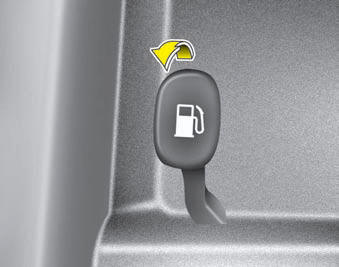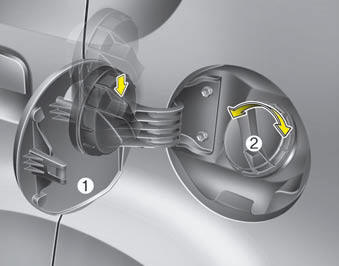Fuel filler lid

Opening the fuel filler lid The fuel filler lid must be opened from inside the vehicle by pulling up the fuel filler lid opener lever.
NOTICE
If the fuel filler lid does not open
because ice has formed around it, tap
lightly or push on the lid to break the ice
and release the lid. Do not pry on the lid.
If necessary, spray around the lid with an approved de-icer fluid (do not use radiator anti-freeze) or move the vehicle to a warm place and allow the ice to melt.

1. Stop the engine.
2. To open the fuel filler lid, pull the fuel filler lid opener (if equipped) up.
3. Pull open the fuel filler lid (1).
4. To remove the cap, turn the fuel filler cap (2) counterclockwise.
5. Refuel as needed.
Closing the fuel filler lid 1. To install the cap, turn it clockwise until it “clicks”. This indicates that the cap is securely tightened.
2. Close the fuel filler lid and push it in lightly making sure that it is securely closed.
WARNING - Refueling
• If pressurized fuel sprays out, it
can cover your clothes or skin
and subject you to the risk of fire
and burns. Always remove the
fuel cap carefully and slowly. If
the cap is venting fuel or if you
hear a hissing sound, wait until
the condition stops before completely
removing the cap.
• Do not "top off" after the nozzle automatically shuts off when refueling.
• Tighten the cap until it clicks, otherwise
the Check Engine light
will illuminate.
• Always check that the fuel cap is installed securely to prevent fuel spillage in the event of an accident.
WARNING - Refueling dangers Automotive fuels are flammable materials. When refueling, please note the following guidelines carefully.
Failure to follow these guidelines may result in severe personal injury, severe burns or death by fire or explosion.
• Read and follow all warnings posted at the gas station facility.
• Before refueling, note the location of the Emergency Gasoline Shut-Off, if available, at the gas station facility.
• Before touching the fuel nozzle, you should eliminate potentially dangerous static electricity discharge by touching another metal part of the vehicle, a safe distance away from the fuel filler neck, nozzle, or other gas source.
• Do not get back into a vehicle once you have begun refueling since you can generate static electricity by touching, rubbing or sliding against any item or fabric (polyester, satin, nylon, etc.) capable of producing static electricity.
Static electricity discharge
can ignite fuel vapors resulting in
rapid burning. If you must reenter
the vehicle, you should
once again eliminate potentially
dangerous static electricity discharge
by touching a metal part
of the vehicle, away from the fuel
filler neck, nozzle or other gasoline
source.
• When using an approved portable fuel container, be sure to place the container on the ground prior to refueling. Static electricity discharge from the container can ignite fuel vapors causing a fire. Once refueling has begun, contact with the vehicle should be maintained until the filling is complete.
Use only approved portable plastic fuel containers designed to carry and store gasoline.
• Do not use cellular phones while
refueling. Electric current and/or
electronic interference from cellular
phones can potentially
ignite fuel vapors causing a fire.
• When refueling, always shut the engine off. Sparks produced by electrical components related to the engine can ignite fuel vapors causing a fire. Once refueling is complete, check to make sure the filler cap and filler door are securely closed, before starting the engine.
• DO NOT use matches or a lighter and DO NOT SMOKE or leave a lit cigarette in your vehicle while at a gas station especially during refueling. Automotive fuel is highly flammable and can, when ignited, result in fire.
• If a fire breaks out during refueling, leave the vicinity of the vehicle, and immediately contact the manager of the gas station and then contact the local fire department.
Follow any safety instructions they provide.
CAUTION
• Make sure to refuel with unleaded
fuel only.
• If the fuel filler cap requires replacement, use only a genuine KIA cap or the equivalent specified for your vehicle. An incorrect fuel filler cap can result in a serious malfunction of the fuel system or emission control system.
• Do not spill fuel on the exterior surfaces of the vehicle. Any type of fuel spilled on painted surfaces may damage the paint.
• After refueling, make sure the fuel cap is installed securely to prevent fuel spillage in the event of an accident.
See also:
Mirrors
Inside rearview mirror
Adjust the rearview mirror to center on
the view through the rear window. Make
this adjustment before you start driving.
WARNING: - Rear visibility
Do not place objects in ...
Automatic transaxle
Automatic transaxle operation
The highly efficient automatic transaxle
has 5 forward speeds and one reverse
speed. The individual speeds are selected
automatically, depending on the position
of ...
Engine compartment
Gasoline Engine (2.4L)
1. Engine coolant reservoir
2. Engine oil filler cap
3. Brake fluid reservoir
4. Air cleaner
5. Fuse box
6. Negative battery terminal
7. Positive battery terminal
8. A ...


